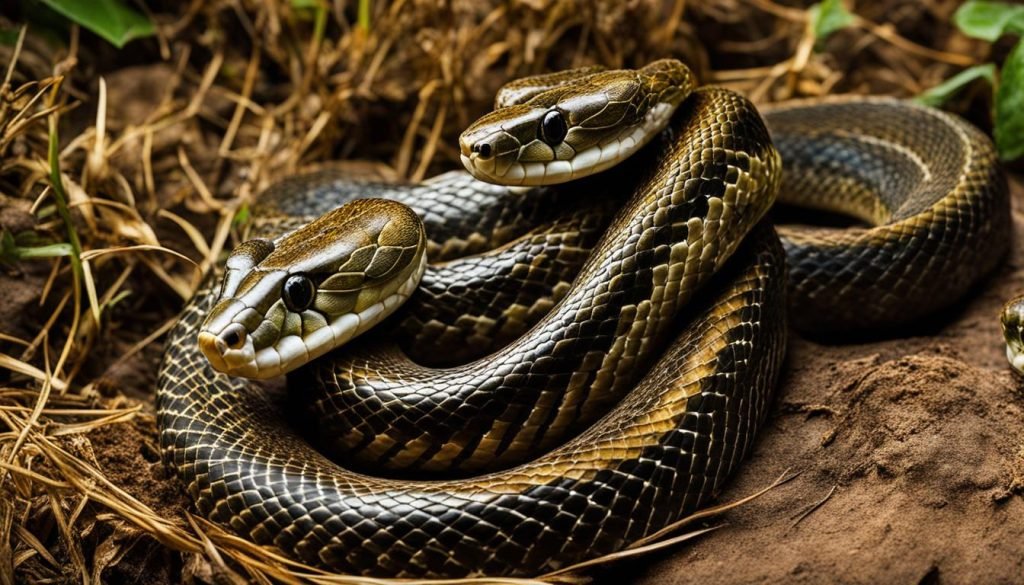How Do Snakes Mate? Snakes Mating Explained
Snakes are fascinating creatures with unique behaviors, including their mating habits. Have you ever wondered how snakes reproduce? In this section, we will explore the intricacies of snake mating behavior and the reproduction process.
Snakes employ a variety of strategies during their mating process, from courtship rituals to copulation mechanics. Understanding these behaviors and anatomical features is crucial to comprehend fully how snakes mate.
Key Takeaways
- Snakes have unique mating behaviors that play a crucial role in their reproduction process
- Understanding snake reproductive anatomy is essential to comprehend fully their mating behavior
- Snake mating involves specific mechanics that allow for successful copulation
- Snakes have particular times of the year when they engage in mating activities
- Understanding how snakes mate sheds light on their survival and species continuation
Snake Courtship Rituals

Snakes have unique courtship rituals that are vital to their mating process. These behaviors involve a complex dance of body movements, pheromone communication, and vocalizations. The purpose of these rituals is to identify compatible mates and ensure successful breeding.
One of the most common courtship behaviors exhibited by snakes is the use of scent. Female snakes release pheromones to signal their readiness to mate, which males detect using their tongue’s Jacobson’s organ. The male then follows the scent trail to the female’s location.
Once the male and female snakes have found each other, they engage in a dance of movements that showcases their physical characteristics. Some species, like ball pythons, engage in a prolonged dance that involves wrapping their bodies around each other in intricate patterns. Other snake species, like rat snakes, engage in more straightforward courtship rituals that involve arching their bodies and vibrating their tails.
The length and complexity of snake courtship rituals vary depending on the species and individual. The behavior is influenced by a variety of factors, including temperature, humidity, and light levels. For example, male rattlesnakes engage in more elaborate courtship rituals when the temperature is higher, signaling optimal conditions for breeding.
Snake Quiz
How well do you know snakes? Test your knowledge below!

| Snake Breeding Habits | Snake Courtship Rituals |
|---|---|
| Snakes breed during specific times of the year, depending on their species. | Snake courtship rituals involve the use of scent and body movements to find compatible mates. |
| Some species engage in prolonged courtship dances involving intricate body movements, while others have simpler rituals. | Courtship behavior is influenced by various factors, including temperature and humidity levels. |
Overall, snake courtship rituals are a fascinating aspect of their mating process. Understanding these behaviors is essential to appreciate the complexity of their reproductive behavior fully.
Snake Reproductive Anatomy

Understanding the reproductive anatomy of snakes is essential in comprehending their mating process fully. Unlike mammals, snakes have a unique reproductive system that involves the use of hemipenes, which are paired male reproductive organs. Both male and female snakes have cloacae, which are openings that serve as the exit for waste and the entrance for reproductive fluids during copulation.
The female reproductive system consists of two ovaries that produce eggs, which travel through the oviducts before being laid. In some species, the oviducts merge to form a single cloaca that serves as the primary site of egg fertilization.
Male snakes have testes located inside their body, which produce sperm that travels through ducts before being released through the hemipenes. Hemipenes differ in shape and size between species and are used to deposit sperm into the female reproductive tract during copulation.
It is important to note that not all snakes have the same reproductive anatomy. Species differ in the number of hemipenes, the structure of the cloaca, and the location of the testes, making each species’ reproductive anatomy unique.
Snake Reproductive Cycle: How Do Snakes Mate?

The snake reproductive cycle is dependent on various factors, including species, climate, and food availability. Most snake species are oviparous, meaning they lay eggs, while others are ovoviviparous, meaning they give birth to live young that develop within eggs inside the female’s body.
The reproductive cycle can be divided into two stages: the mating season and the gestation period. The mating season is the time of the year when snakes engage in courtship behaviors and copulation, which leads to egg fertilization. The gestation period, which varies between species, is the time when the female carries the eggs or embryos inside her body before laying or giving birth to offspring.
The length of the gestation period and the number of offspring produced vary depending on the species. For example, some species, such as the garter snake, may produce dozens of offspring at once, while others, such as the rock python, may lay as few as six eggs.
Understanding the reproductive anatomy of snakes is essential in comprehending their mating process fully.
In conclusion, the reproductive anatomy and cycle of snakes involve unique characteristics and behaviors that play a crucial role in their survival and the continuation of their species. Understanding these intricacies provides insight into the complex yet fascinating world of snake reproduction.
Snake Mating Mechanics
Snake mating involves specific mechanics that allow for successful copulation. These mechanics vary across different snake species and depend on their physical characteristics. Some snakes have elaborate courtship rituals, whereas others use brute force.
During mating, male snakes usually approach females from the rear and align their cloacae. The cloaca is a multi-purpose opening that serves as the exit point for feces, urine, and reproductive fluids.
Corn snakes, for example, engage in a complex dance where males rub their chins on the female’s neck before copulation. This behavior stimulates the female’s reproductive system and induces ovulation.
Once the male has positioned himself behind the female, he inserts one of his hemipenes, a specialized reproductive organ found in snakes and lizards, into the female’s cloaca. Hemipenes come in various shapes and sizes, depending on the species, and can have spines that aid in grasping the female’s cloaca during copulation.
The duration of copulation can last from a few minutes to several hours, depending on the species. Some snakes, like garter snakes, may engage in “breeding balls,” where multiple males entwine themselves around a female in a frenzied attempt to mate.
After copulation, fertilization occurs internally, and the female will lay eggs or give birth to live offspring, depending on the species.
Interestingly, some female snakes can store sperm for extended periods and control when they fertilize their eggs, allowing them to ensure successful reproduction even if they don’t mate every year.
Understanding snake mating mechanics is vital for snake breeders and enthusiasts, as it can aid in successful breeding and captive management.
Snake Mating Season
Snakes mate during specific times of the year, known as the snake mating season. The timing of this season varies depending on the species and geographic location.
For example, in North America, many snake species mate in the spring, after emerging from hibernation. The warmer temperatures and longer days trigger their reproductive cycle. In contrast, some tropical snake species may mate year-round, as the climate remains consistent throughout the year.
The duration of the snake mating season can also vary. Some species mate for only a few weeks, while others may mate for several months. During this time, males compete for the attention of females through various courtship behaviors.
Did You Know? Some species of snakes exhibit communal mating, where multiple males mate with a single female. This behavior is especially prevalent in some species of garter snakes.
Understanding the timing and behaviors associated with the snake mating season is critical for their survival and the continuation of their species. Any changes in their environment or climate can significantly impact their reproductive success and population size.
Snakes in Captivity
For snakes kept in captivity, their mating season can differ from their wild counterparts due to the controlled conditions they live in. Some breeders may simulate the environmental changes that trigger snake mating behavior to encourage breeding.
However, it’s important to note that breeding snakes in captivity requires extensive knowledge and experience. Improper breeding practices can result in health issues or even death for the snakes involved.
Overall, understanding the snake mating season is vital to understanding the life cycle of these fascinating reptiles.
Conclusion: Snake Mating
The process of snake mating is a captivating aspect of these reptiles’ lives. From courtship rituals to reproductive anatomy, their mating behavior reveals a complex yet fascinating world.
Snake Mating Behavior and Reproduction Process
Understanding how snakes mate sheds light on their survival and the continuation of their species. Snake mating behavior and the intricate reproduction process they follow are critical components of this survival.
Snake Courtship Rituals and Breeding Habits
Snake courtship rituals play a crucial role in their mating process, with various behaviors exhibited by these reptiles. By discovering the importance of these rituals, we can better understand the success rate of their breeding habits.
Snake Reproductive Anatomy and Cycle
Exploring the reproductive anatomy of snakes is essential to understanding their mating process fully. The details of snake reproductive organs and the intricacies of their reproductive cycle provide insight into their survival as a species.
Snake Copulation Mechanics
Snake mating involves using specific mechanics that allow for successful copulation. Understanding these unique methods and how their physical characteristics aid in the process is crucial to gaining a deeper insight into snake mating behavior.
Snake Mating Season
Snakes have specific times of the year when they engage in mating activities. Exploring the concept of snake mating seasons and the factors that influence when and why snakes reproduce during certain periods helps us further understand their behavior.
The fascinating world of snake mating is critical to the survival of these reptiles. By understanding their mating behavior, reproductive process, courtship rituals, and breeding habits, we gain valuable insight into the complex yet captivating world of these remarkable creatures.







